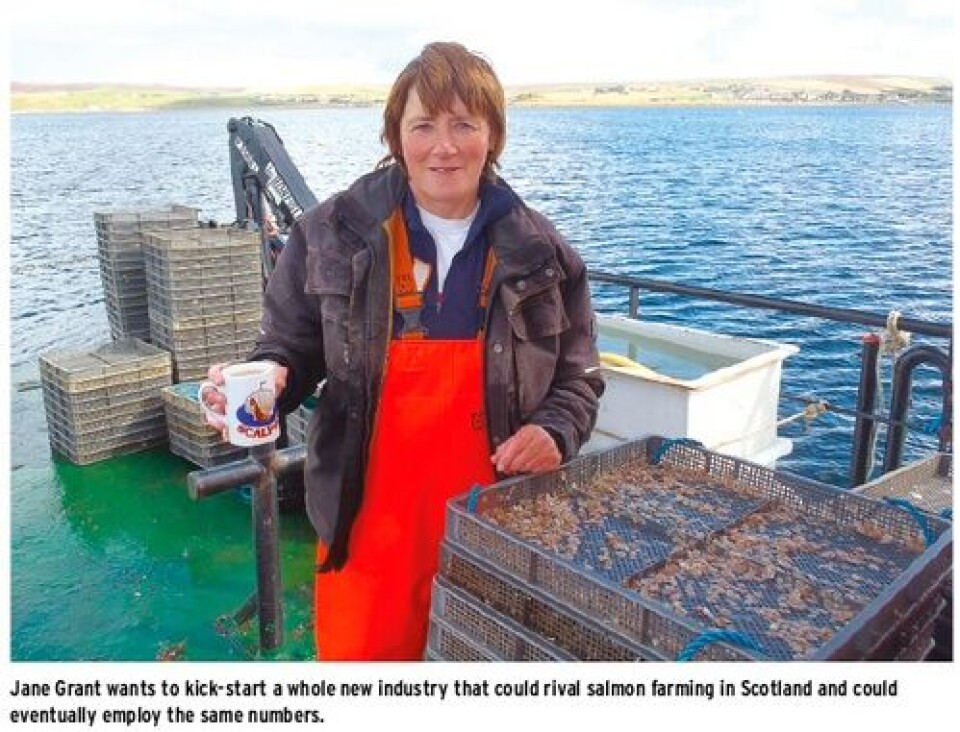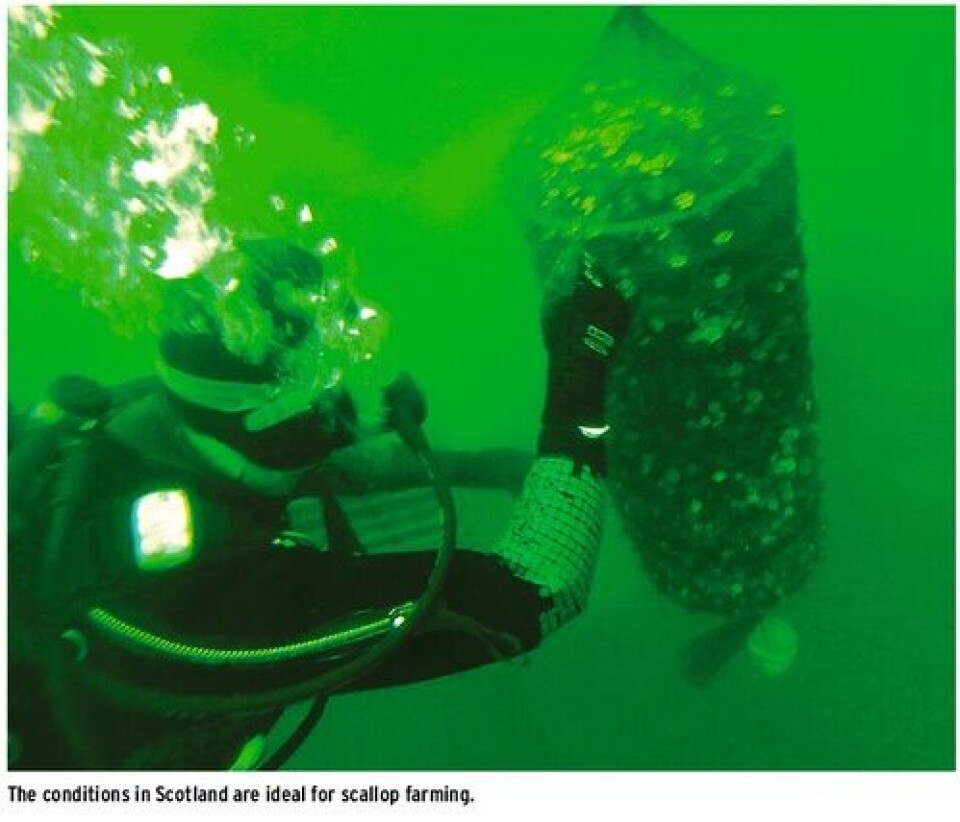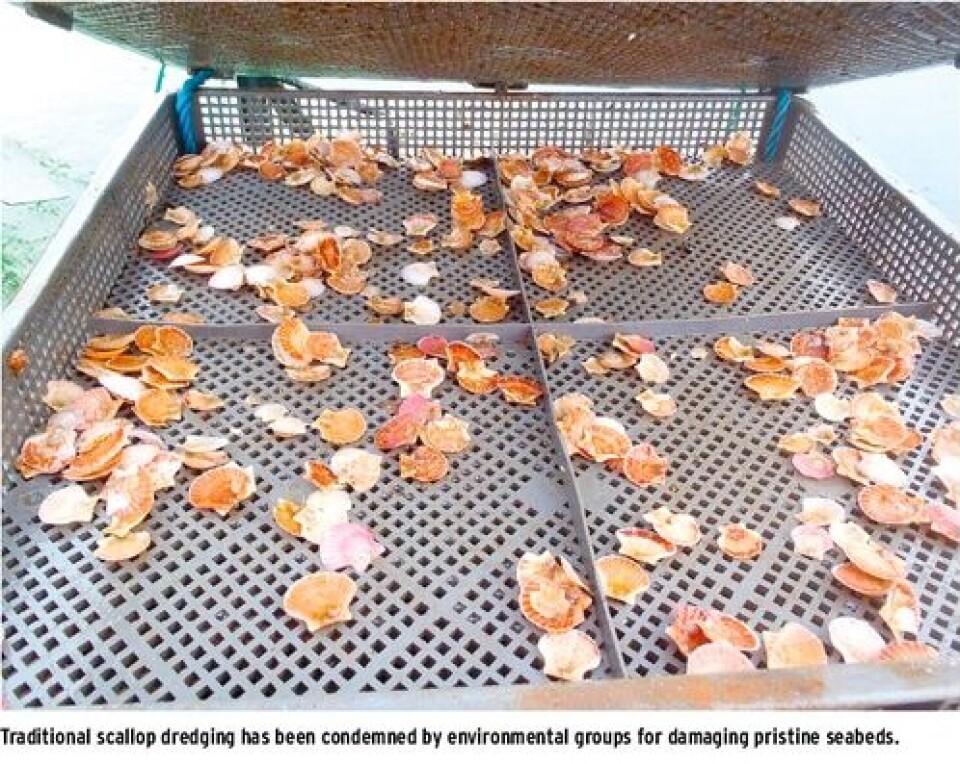New possibilities in shellfish farming
By Siri Elise Dybdal siri@fishfarmingxpert.com
Mussel and Pacific oysters remain the main shellfish species produced in Scotland in terms of both value and tonnage. Oysters and Mussels are grown in sea lochs. They are harvested when they reach market size, which takes 2-3 years. Once harvested, the seafood is cleaned, graded and packed into boxes or nets and transported in chilled trucks to shops, restaurants and often abroad to places like France or Spain. Mussels are sometimes processed and sold cooked, but are more often sold live to restaurants in the UK and abroad, whilst oysters are always sold live.

In addition to mussel and oyster production, there are also ambitious plans to create a new seafood sector in Scotland – scallop farming - that one day could rival the country’s booming salmon farming industry.
The Scottish Government’s target is to increase the shellfish production (especially mussels) to 13,000 tonnes in 2020, from 6,525 tonnes in 2012
Protection of shellfish waters Steps are now being taken to make such growth possible. At the end of 2013, a new legislation came into force to ensure the continued protection of Scottish shellfish growing waters. The measures – the first of their kind in the UK – have been introduced to replace the European Shellfish Waters Directive. To continue support for the expansion of Scotland’s shellfish sector, and ensure a good quality product which is safe for human consumption, 84 shellfish water protected areas (SWPAs) have been identified. Steps will be taken to prevent the deterioration of water quality in these areas, and where necessary to improve water quality to a high standard.
“We want to ensure both sectors have a successful and sustainable future and ensuring Scotland’s precious marine environment is protected is a key part of that. “Shellfish production is important for our rural and coastal communities and we recognise the need for clean water in these areas to ensure a high quality product which is safe for human consumption,” says Environment and Climate Change Minister Paul Wheelhouse.

“It’s important that we maintain the current high standards of water quality, but also protect against and reduce pollution in shellfish waters. These new measures not only do that, but also significantly expand the area of water protected to enhance support for shellfish life and increase the number of high class edible shellfish products,” he emphasises.
Small producers dominate According to the Scottish Shellfish Farm Production Survey 2012, production was dominated by mussel and Pacific oyster, although small quantities of scallop, queen scallop (queen) and native oyster were also produced.
At the end of 2012, there were 153 shellfish farming businesses authorised in Scotland, which farmed 330 active sites, of which 163 (49%) placed shellfish on the market. The sector employed 171 full-time and 187 part-time and casual workers during 2012.
The industry mostly consists of small producers, although the 2012 survey revealed that there was a continued and marked trend toward large businesses contributing to the annual production of all species.
There were 16 businesses producing more than 100 tonnes of mussels, an increase of one business since 2011. Out of these 16 companies, six produced more than 300 tonnes. These six companies produced 58% of the total mussel production in Scotland. There were two businesses that produced more than 300,000 Pacific oysters - this is two less than the 2011 total. The production of these two businesses’ accounted for 35% of the Scottish total.

An example of large businesses contributing to the annual production of all species is Loch Fyne Oysters Limited, which in January 2014 acquired the Hebridean Mussels and Hebridean Seafoods operations as part of an ongoing strategy to increase its shellfish production.
Owner Cree MacKenzie who founded both companies in 1992 said: “We see LFO as the ideal company to continue to develop mussel farming and processing in Loch Roag on the Isle of Lewis and Lamlash Bay on the Isle of Arran with their proven track record of rearing and supplying a variety of shellfish to the highest quality standards and will secure and increase employment in the local area.” Prices of farmed shellfish fluctuated throughout the year. The average price of Pacific oyster was £0.35 per shell; native oyster, £0.60 per shell; scallop, £1.70 per shell; queen scallop, £0.10 per shell; and mussels £1,200 per tonne.
The value of the table trade Mussel: £7.5 million Pacific oyster: £0.95 million Native oyster: £0.19 million Scallop: £0.10 million Queen: £0.001 million
The 2012 total value, at first sale for all species, was estimated at £8.7 million a decrease from £9.8 million in 2011.

Despite the Government’s plans of expanding the industry, the report showed that mussel production for the table, decreased by 10% from the 2011 total. Survey responses attribute the cause of the decrease to be environmental effects such as variation of spat settlement in time and place in recent years. The greatest contribution in regional mussel production was from Shetland, accounting for 4,340 tonnes or 69% of Scotland’s total. The results of poor mussel spat settlement investigations in 2011, including a questionnaire to industry, indicated that poor spat settlement and mortality was not widespread in Scottish waters, although a major impact on certain individual producers. The causes are associated with environmental variables, guiding industry to consider focussed spat fall monitoring to help predict spat settlement in time and space. Communication among industry, MS policy and scientists is to continue to determine the need and focus for possible research and development.
Pacific oyster production decreased by 14% from 2011 reportedly due to losses from severe weather conditions and the impact of a significant producer ceasing to trade. Meanwhile, production of Pacific oysters for on-growing has significantly increased, supplying markets within and outwith Scottish waters. The Strathclyde region produced about 86% of Scotland’s farmed Pacific oysters.
Production of native oysters decreased by 9% from 2011. Native oyster production accounts for a small percentage of total oyster production, however, demand for this species continues to be high.
Queen and scallop production target a small niche market, however production fell by 67% and 26% respectively since 2011. A contributing factor was reported as poor spat settlement. Scallop-farming is, however, a target area for the future in Scotland.
A future scallop industry The king scallop is one of Scotland’s prime seafood catches. But traditional scallop dredging has been condemned by environmental groups for damaging pristine seabeds, while attempts to develop a viable scallop farming sector in Scotland have so far failed.
The only Scottish company currently farming scallops is Scot-Hatch, which works with the Norwegian company Scalpro AS. Scot-Hatch is based at Loch Ewe, south of Ullapool. The company is run by Grant Campbell, a professional scallop diver, and Jane Grant, who operated a scallop farming business on the west coast for ten years until the lack of wild spat (young scallops) forced her to wind up the business.
Last year they produced 750,000 scallops from juvenile spats. These came from scallops caught in Scottish waters and sent to Norway to spawn. The company hopes to grow 2.5 million this year. “The first step in scallop ranching is to source the young scallops, known as spat. This can be done by catching the naturally occurring spat in the sea at a microscopic stage or by using a scallop hatchery. “We have been able to send our scallops from Scotland to Norway for breeding. The offspring has then been returned to us for on-growing. These young scallops have been produced ‘out of season’ and this means that their growth is far in advance of what could be seen in the wild. The benefits of this cannot be understated; a 20% reduction in production time and even more importantly, a 40% reduction in the time spent in the costly, labour intensive part of the production cycle. This is a huge boost since it can take 5-6 years to grow a King Scallop of real quality,” says Grant.

Scottish hatchery Scot-Hatch is currently in talks with investors in order to build a scallop hatchery in Scotland, which could be used by those keen to get involved in the new seafood sector. “We want to kick-start a whole new industry that could rival salmon farming in Scotland and could eventually employ the same numbers. We are trying to do something major for the whole of the Highlands and the west coast of Scotland.” She added that, unlike salmon farming, there were no problems with feed and chemicals. “We don’t feed scallops, we don’t treat them with anything. All they need is clean water. Once they are the right size we put them on the seabed and try to protect them from predators, like starfish and crabs. And they will stay there for three to four years before we send down divers to pick them up.” According to Grant, Norway, has poured money into hatcheries, but never managed to grow the spat, partly because the water is too cold. “But we believe the conditions in Scotland are ideal.
“We are not trying to ostracise the dredger fleet. What we are saying to the scallop dredgers is that they could buy small scallops from us, put them down and leave those areas free from dredging for four or five years before they harvest them. It could be a win-win. We are convinced that Scotland can have a thriving, profitable industry that is sustainable, of low environmental impact and that can bring valuable employment to fragile communities.”
Grant says the company’s aim is to have the hatchery up and running by 2016. She says that within 8-10 years, Scotland could have a large scallop farming industry. “The survivability from the hatchery is huge,” she adds.
She is not worried about market demand, and points out that the opening of the Far East markets are a great potential outlet. Scot-Hatch has had Chinese and Japanese delegates visiting who were very impressed by the size and quality of the scallops.
Highlands & Islands Enterprise has also expressed its view that king scallop ranching could become an important and sustainable industry in Scotland and will discuss the topic discussed at a meeting held in its Inverness HQ on 18 February.























































